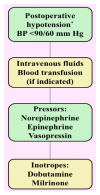Postoperative Management in Patients with Pheochromocytoma and Paraganglioma
- PMID: 31277296
- PMCID: PMC6678461
- DOI: 10.3390/cancers11070936
Postoperative Management in Patients with Pheochromocytoma and Paraganglioma
Abstract
Pheochromocytomas and paragangliomas (PPGLs) are rare catecholamine-secreting neuroendocrine tumors of the adrenal medulla and sympathetic/parasympathetic ganglion cells, respectively. Excessive release of catecholamines leads to episodic symptoms and signs of PPGL, which include hypertension, headache, palpitations, and diaphoresis. Intraoperatively, large amounts of catecholamines are released into the bloodstream through handling and manipulation of the tumor(s). In contrast, there could also be an abrupt decline in catecholamine levels after tumor resection. Because of such binary manifestations of PPGL, patients may develop perplexing and substantially devastating cardiovascular complications during the perioperative period. These complications include hypertension, hypotension, arrhythmias, myocardial infarction, heart failure, and cerebrovascular accident. Other complications seen in the postoperative period include fever, hypoglycemia, cortisol deficiency, urinary retention, etc. In the interest of safe patient care, such emergencies require precise diagnosis and treatment. Surgeons, anesthesiologists, and intensivists must be aware of the clinical manifestations and complications associated with a sudden increase or decrease in catecholamine levels and should work closely together to be able to provide appropriate management to minimize morbidity and mortality associated with PPGLs.
Keywords: arrhythmia; hypertension; hypotension; pheochromocytoma; postoperative.
Conflict of interest statement
The authors declare no conflict of interest.
Figures




Similar articles
-
Pediatric Metastatic Pheochromocytoma and Paraganglioma: Clinical Presentation and Diagnosis, Genetics, and Therapeutic Approaches.Front Endocrinol (Lausanne). 2022 Jul 12;13:936178. doi: 10.3389/fendo.2022.936178. eCollection 2022. Front Endocrinol (Lausanne). 2022. PMID: 35903274 Free PMC article. Review.
-
Cardiovascular Manifestations and Complications of Pheochromocytomas and Paragangliomas.J Clin Med. 2020 Jul 30;9(8):2435. doi: 10.3390/jcm9082435. J Clin Med. 2020. PMID: 32751501 Free PMC article. Review.
-
Hemodynamic instability during percutaneous ablation of extra-adrenal metastases of pheochromocytoma and paragangliomas: a case series.BMC Anesthesiol. 2018 Nov 6;18(1):158. doi: 10.1186/s12871-018-0626-1. BMC Anesthesiol. 2018. PMID: 30400849 Free PMC article.
-
Histopathological analysis of spontaneous large necrosis of adrenal pheochromocytoma manifested as acute attacks of alternating hypertension and hypotension: a case report.J Med Case Rep. 2016 Oct 12;10(1):279. doi: 10.1186/s13256-016-1068-3. J Med Case Rep. 2016. PMID: 27729064 Free PMC article.
-
Surgical strategies of complicated pheochromocytomas/paragangliomas and literature review.Front Endocrinol (Lausanne). 2023 Apr 21;14:1129622. doi: 10.3389/fendo.2023.1129622. eCollection 2023. Front Endocrinol (Lausanne). 2023. PMID: 37152961 Free PMC article. Review.
Cited by
-
Elemental Composition of Pheochromocytoma Resolved on Solid/Adrenal Tissue and Whole Blood Level.Biol Trace Elem Res. 2022 Aug;200(8):3482-3490. doi: 10.1007/s12011-021-02945-2. Epub 2021 Oct 6. Biol Trace Elem Res. 2022. PMID: 34613583
-
The frequency of postoperative hypoglycemia after pheochromocytoma surgery is decreasing.World J Surg. 2024 Dec;48(12):2918-2924. doi: 10.1002/wjs.12368. Epub 2024 Oct 9. World J Surg. 2024. PMID: 39384339 Free PMC article.
-
Perioperative Blood Pressure Management Recommendations in Pediatric Pheochromocytoma: A 10-Year Narrative Review.Kidney Blood Press Res. 2025;50(1):61-82. doi: 10.1159/000542897. Epub 2024 Dec 3. Kidney Blood Press Res. 2025. PMID: 39626645 Free PMC article. Review.
-
Clinical and genetic features of older patients with pheochromocytomas and paragangliomas: A multicenter retrospective study.J Endocrinol Invest. 2025 Aug 20. doi: 10.1007/s40618-025-02689-z. Online ahead of print. J Endocrinol Invest. 2025. PMID: 40833586
-
Deliberate Compensated Vasoplegia-A Novel Pharmaceutical Approach for Controlling Blood Pressure During Surgery for Pheochromocytoma.World J Surg. 2023 Apr;47(4):985-994. doi: 10.1007/s00268-023-06894-w. Epub 2023 Jan 23. World J Surg. 2023. PMID: 36688933
References
Publication types
LinkOut - more resources
Full Text Sources

